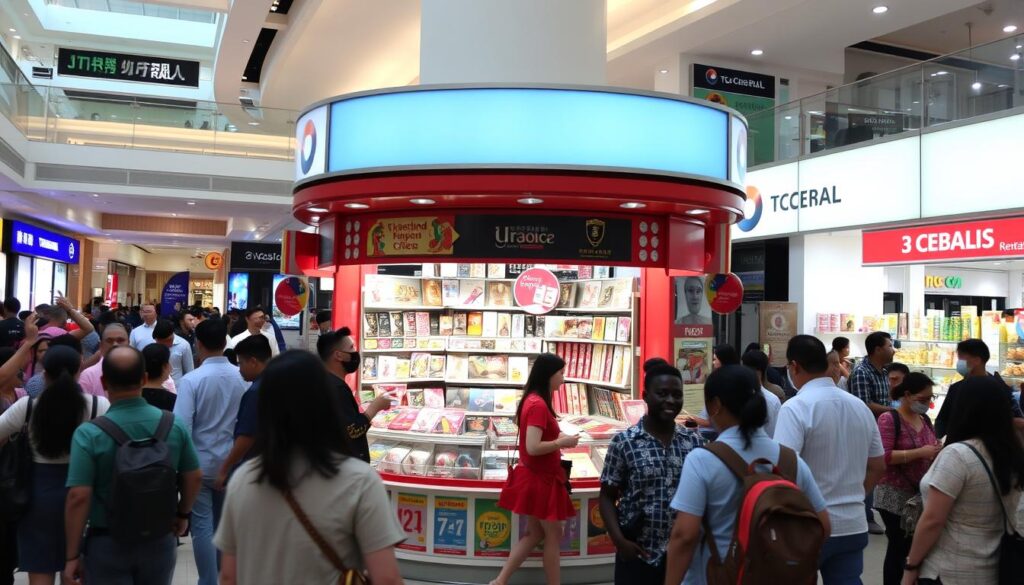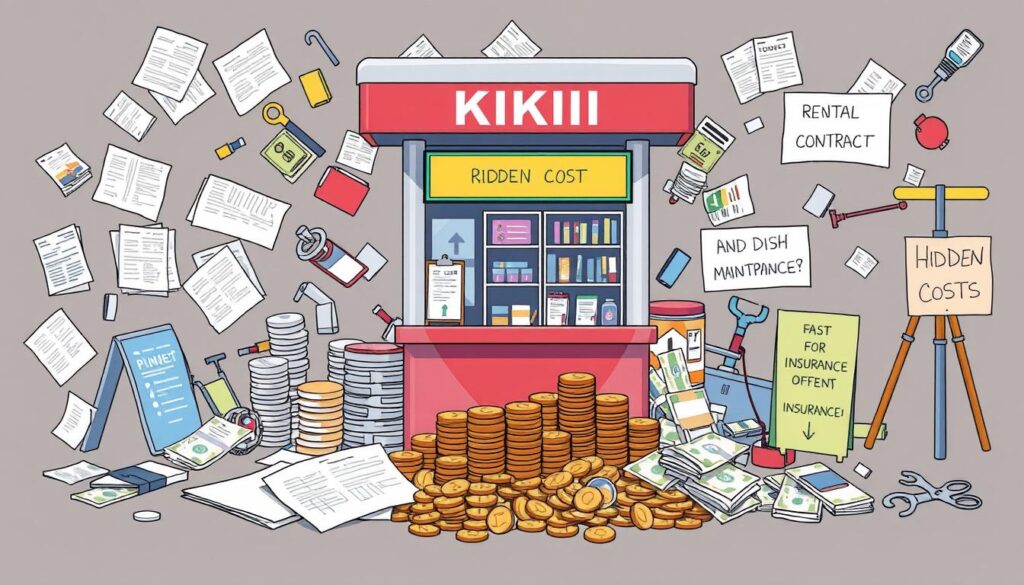Knowing the retail kiosk rental cost is key for entrepreneurs wanting to set up in busy places like malls and airports. With more competition in retail, it’s important to understand mall kiosk leasing prices well. Many start-ups guess their costs, but a detailed look can really make a difference in their success.
Many things affect these costs, like where you are, how long you lease, and shared costs. For example, a spot in a popular mall might cost about $23 per square foot. But a similar spot just a half mile away could be as low as $11 per square foot. This shows how important it is to do your homework.
Also, think about the extra costs of triple net leases. These can include property taxes, insurance, and Common Area Maintenance (CAM). These can add about $200 to your monthly bills.
Short-term leases can be a good option for businesses wanting to try out new markets or seasons. Start-ups might choose coworking spaces or shared areas to save money. This shows how important it is to plan carefully in the competitive retail world.

Key Takeaways
- Averaging $23 per square foot, retail rents can vary significantly based on location.
- Short-term and seasonal rentals like kiosks can reduce financial burden.
- Triple net leases typically add around $200 monthly in additional costs.
- Understanding all components of rental costs is essential for informed budgeting.
- Researching shared spaces can provide cost-saving opportunities for startups.
Factors Influencing Kiosk Rental Costs
Knowing what affects kiosk rental costs is key for those thinking about this business model. Location, size and type of kiosk, rental time, and lease features all play a big role. Each factor impacts the total cost a business owner must think about when signing a lease.
Location, Location, Location: Prime Spots vs. Less Trafficked Areas
The spot where a kiosk retail is placed greatly affects its rental price. Kiosks in busy places like malls cost more. These spots get more people walking by, which can lead to more sales. On the other hand, kiosks in less busy areas cost less but might find it harder to get customers.
Kiosk Size and Type: Compact Carts vs. Elaborate Structures
The size and type of kiosk also matter. Smaller carts cost less because they need less space and materials. Bigger, more complex kiosks cost more in rent and upkeep. Knowing this helps businesses plan their budget better.
Rental Duration: Short-Term vs. Long-Term Leases
The length of the lease affects the price. Short-term leases cost more each month than long-term ones. Businesses looking for temporary spots should keep this in mind. Long-term leases can mean more stable payments and lower costs overall.
Features and Amenities: Basic vs. High-End Inclusions (e.g., electricity, internet)
Lastly, what’s included in the lease also changes the cost. Simple kiosks without things like electricity and internet cost less. More advanced kiosks with these extras cost more. This helps renters match their needs and budget.
| Factor | Influence on Cost |
|---|---|
| Location | Higher foot traffic equals higher rental charges |
| Kiosk Size and Type | Compact kiosks are generally cheaper |
| Rental Duration | Short-term leases are pricier per month |
| Features and Amenities | Advanced setups require higher investment |
Typical Kiosk Rental Costs
For businesses wanting to enter the kiosk market, knowing the costs is key. Location is a big factor in pricing. Here’s a look at what you might pay for different kiosk types.
Mall Kiosks: Breaking Down Average Rental Fees
Mall kiosks are sought after for their foot traffic. Prices can range from $1,500 to over $8,000 a month. This depends on the mall’s reputation and where it’s located. Size, utilities, and lease length also play a role.
Airport Kiosks: Navigating Premium Pricing and Concession Agreements
Airport kiosks cost more due to their prime location and customer flow. Businesses must also deal with strict concession agreements. This can increase costs and what’s needed to operate.
Pop-Up Kiosks: Short-Term Costs and Flexible Options
Pop-up kiosks are for seasonal or event-based businesses. They’re cheaper than long-term leases, making them flexible. This lets entrepreneurs test products in busy spots without a long-term commitment.
Outdoor Kiosks: Understanding Permit Fees and Location-Specific Costs
Outdoor kiosks have unique costs, like permit fees and location-specific charges. These can change based on local rules and demand. Businesses need to include these costs in their budget, along with rent.

| Kiosk Type | Average Monthly Cost | Factors Impacting Price |
|---|---|---|
| Mall Kiosk | $1,500 – $8,000 | Location, Size, Lease Terms |
| Airport Kiosk | Premium Pricing | Traffic, Concession Agreements |
| Pop-Up Kiosk | Varies – Typically Lower | Flexibility, Seasonal Demand |
| Outdoor Kiosk | Variable Costs | Permit Fees, Location Regulations |
Hidden Costs to Consider
Running a kiosk is more than just paying the rental fees. There are hidden costs that can increase your expenses. Knowing these costs helps you make better financial choices.
Utilities: Electricity, Internet, and Other Essential Services
Utility costs are key when planning your kiosk’s budget. Electricity and internet costs can change based on how much you use and where you are. In shared spaces, bills can cause problems if not split right.
It’s important to think about both high and low usage times for electricity. This affects your budget planning.
Insurance: Protecting Your Business and Assets
Insurance is vital to protect your kiosk from harm or legal issues. Business interruption insurance costs between $500 and $1,500 a year. General liability insurance for small businesses is about $40 to $50 monthly.
Other insurance needs, like workers’ compensation or property insurance, can add more costs. These can be around $63 a month.
Maintenance and Repairs: Keeping Your Kiosk in Top Shape
Keeping your kiosk running smoothly requires regular maintenance and repairs. These costs are part of the rental fees. Lease agreements often specify who pays for what, which can lead to disagreements.
Staffing: Hiring and Managing Employees
Staffing costs are another hidden expense. For example, a retail cashier in the U.S. makes about $25,900 a year. When planning your kiosk’s finances, remember to include costs for hiring, training, and managing staff. This helps avoid unexpected money problems.

Negotiating and Budgeting
Effective negotiation is key to managing kiosk rental costs. Knowing the local market helps kiosk owners get better lease terms. By researching similar rentals, they can make a strong case to landlords.
Tips for Negotiating Favorable Rental Terms
To get the best lease, try these strategies:
- Research market rates for similar spaces in the area.
- Understand the landlord’s motivations and needs.
- Negotiate based on property aspects, such as age and condition.
- Discuss possible concessions, like covering renovation costs for longer leases.
- Write down all agreements, even verbal ones.
- Get a commercial real estate attorney to check lease terms.
Creating a Realistic Budget for Your Kiosk Business
Creating a budget means thinking about all costs for your kiosk. Here are some to consider:
| Expense Type | Estimated Monthly Cost |
|---|---|
| Base Rent (for 1,000 sq ft) | $3,750 |
| Utilities | ~$125 (estimated) |
| Insurance | Varies (based on coverage) |
| Marketing | Varies (based on strategy) |
| Inventory Costs | Varies (based on merchandise) |
Remember to plan for short-term leasing costs and utility fees to avoid financial trouble.
Exploring Financing Options and Incentives
Kiosk operators should look into different financing options to help with startup costs:
- Search for small business grants and loans.
- Check out local incentives or incubator programs.
- Consider subleasing to lower initial costs.
- Look at financing plans that let you buy equipment gradually.
Cost-Saving Strategies
Effective cost-saving strategies can greatly improve a kiosk’s financial health. By planning carefully and making smart choices, business owners can manage mall kiosk rental costs well. This helps them keep their profit margins high.
Sharing Kiosk Space with Complementary Businesses
Sharing kiosk space is a smart move. Partnering with businesses that offer similar products can lower leasing costs. It also opens up chances for cross-marketing, benefiting both sides.
Opting for Off-Peak Seasons or Less Prime Locations
Operating during off-peak seasons or in less busy areas can save a lot. Lower demand means better rental deals. This way, kiosk operators can save money upfront while keeping a loyal customer base.
Negotiating for Inclusive Packages (e.g., utilities, maintenance)
Negotiating for all-inclusive rental agreements can make budgeting easier. Combining utilities and maintenance into one payment simplifies cash flow. It also reduces the hassle of managing separate bills.
Leveraging Technology to Reduce Staffing Needs
Investing in technology can also cut costs. Using self-service kiosks and online ordering systems reduces the need for staff. This not only improves customer service but also boosts operational efficiency.
By using these strategies, kiosk operators can achieve long-term success. They can handle the challenges of mall kiosk rental costs effectively. In today’s competitive retail world, being proactive is key.
Conclusion
Understanding the costs of retail kiosk rentals is key to success in the competitive world of temporary storefronts. Various factors affect pricing, and knowing both typical and hidden costs is important. This knowledge helps businesses make smart choices that meet their goals.
Making Informed Decisions
Pop-up retail trends show that adapting to the market can boost profits. For example, starting a business like Galerie de Beaute can cost up to $240,000. This highlights the need for careful planning and ongoing evaluation.
With about 4,800 licensed professionals in Ourstate, there are chances for innovative, cost-effective market entry through kiosks like touch display on screen monitor on a kiosk. Knowing the costs of kiosk rentals helps businesses see their financial situation clearly. It also lets them tackle challenges and find ways to make money, ensuring they stay relevant in the changing retail scene.
FAQ
What factors influence retail kiosk rental costs?
Several factors affect retail kiosk rental costs. These include location, kiosk size and type, rental duration, and the features and amenities offered. High-traffic areas usually have higher fees. Compact structures are often more affordable.
What are the average rental fees for mall kiosks?
Mall kiosk leasing prices vary. They range from $1,500 to over $8,000 monthly. This depends on the mall’s location and prestige.
Are there hidden costs associated with kiosk rentals?
Yes, there are hidden costs. These include utilities like electricity and internet, insurance for liability protection, maintenance and repairs, and staffing expenses. It’s key to include these in financial plans.
How can I effectively negotiate kiosk rental terms?
To negotiate better terms, research similar rental costs. Understand the landlord’s needs. Create a detailed budget that includes all costs, like rent and utilities.
What are some cost-saving strategies for kiosk operators?
To save costs, consider sharing space with complementary businesses. Opt for off-peak seasons or less-trafficked locations. Negotiate packages for utilities and maintenance. Use technology to reduce staffing needs.
What types of financing options are available for starting a kiosk business?
Entrepreneurs can look into financing options. These include small business grants, loans, and local incentive programs. They help with the initial capital needed to start a kiosk.
How does rental duration impact kiosk pricing?
Rental duration affects pricing. Short-term space costs are higher per month than long-term leases. It’s important to consider this when budgeting for kiosk rental.